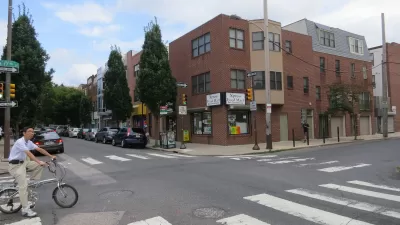I would like to expand an ongoing debate between Reason Foundation policy expert Samuel Staley and me concerning land use policy impacts on affordability and economic stability to include two additional issues: household economic resilience and wealth accumulation.
I would like to expand an ongoing debate between Reason Foundation policy expert Samuel Staley and me concerning land use policy impacts on affordability and economic stability to include two additional issues: household economic resilience and wealth accumulation.
Background: Last month I posted a blog pointed out that smart growth can increase overall affordability by reducing total housing development costs, reducing public service costs and reducing transportation costs, while Staley argued that smart growth policies reduce housing affordabilty and so helps cause the global financial crisis. I responded with another blog that critiquing Staley's analysis (pointing out that correlations between urban growth boundaries and higher housing costs can be explained by the fact that they are generally implemented in areas with rapid growth where land prices are increasing), and provided additional evidence of smart growth economic savings and higher home foreclosure rates in sprawled areas. Staley responded with a defence of his analysis but failed to respond to any other points I had raised, particularly the higher transportation costs of sprawled locations which offset any housing cost savings.
I believe that lower-density, automobile-dependent residential development is even more harmful than indicated in these previous discussions because it exposes households to financial risks and reduces their real estate equity, both of which contributed to the current economic crisis. Put more positively, smart growth helps increase household economic resilience and long-term wealth. This debate concerns the trade-offs households make between cheaper housing and higher transportation costs at the urban fringe and their long-term economic impacts.
First, let's consider the financial risks to households of choosing an automobile-dependent home. Staley's evidence indicating that smart growth areas have higher foreclosure rates is based on highly aggregated data (entire urban regions). More fine-grained analysis, within urban regions, shows much higher foreclosure rates in sprawled location than more central locations. The figure below illustrates this pattern for the city of Houston. Similar patterns are found elsewhere.

Houston region housing foreclosure rates are much higher at the urban fringe,
indicating that sprawl increases household financial risks. (Houston Chronicle)
These higher foreclosure rates can be explained by the additional financial risks associated with automobile dependency. In urban fringe locations, every adult must own an automobile and drive high annual miles. As a result, they are vulnerable to common economic risks: a major vehicle failure or crash, fuel price spikes, a disability, or reduced household income (such as the loss of a job). In contrast, residents of more accessible locations with more diverse transportation systems can respond by reducing their vehicle ownership and relying more on walking, cycling and public transportation, saving thousands of dollars a year. A more accessible location also improves access to well-paying jobs and education opportunities. Households in smart growth locations are therefore more economically resilient. This is particularly important now that so many households are experiencing financial turmoil.
The Institute for Location Efficiency has extensive information on the additional financial costs to consumers of more automobile-dependent, sprawled locations and the savings that they can gain from improved accessibility. They predicted for years that homes in more accessible, multi-modal locations are more financially secure, the current foreclosure crisis has proven that theory.
Second, consider the impacts of automobile dependency on long-term household wealth generation. Motor vehicles depreciate while houses tend to appreciate and so build household wealth.
For example, imagine that a household must choose between a suburban house with a $12,000 annual mortgage and $12,000 annual transportation costs, or an urban house with a $18,000 annual mortgage with only $6,000 in annual transportation costs. Both total $24,000 in combined housing and transportation costs, so they are economically comparable in the short-run. However, money spent on housing builds equity while money spent on motor vehicles does not. As a result, over the long run the urban location provides the household with 50% more equity, probably even more since rising future fuel prices and changing consumer preferences are likely to cause urban housing to appreciate much more than suburban housing during the next two decades. As a result, a typical household is likely to be a hundred thousand dollars wealthier in a decade if they choose a smart growth location over automobile-dependent sprawl.
These give additional support to my previous argument that smart growth is economically superior overall. I am not suggesting that suburban development be prohibited, but it is economically wasteful and cruel to lower-income households to continue public policies that encourage sprawl and discourage smart growth, such as restrictions on development density and multi-family housing, minimum parking supply and setback requirements, and public subsidy of urban fringe infrastructure expansion. Development fees, utility fees and municipal property taxes should reflect the higher costs of providing public services (roads, utilities, emergency response and school busing) in urban fringe locations, so fees and taxes are lower in smart growth locations.
I appreciate comments on this analysis.
For more information see:
Danielle Arigoni (2001), Affordable Housing and Smart Growth: Making the Connections, Subgroup on Affordable Housing, Smart Growth Network (www.smartgrowth.org) and National Neighborhood Coalition (www.neighborhoodcoalition.org).
Scott Bernstein, Carrie Makarewicz, Kara Heffernan, Albert Benedict and Ben Helphand (2004), Increasing Affordability Through Reducing the Transportation and Infrastructure Cost Burdens of Housing, Atlanta Neighborhood Development Partnerships (www.andpi.org); at www.andpi.org/uploadedFiles/pdf/03MICI%20MTC%20Report_CNT.pdf.
CTOD (2009), Mixed-Income Housing TOD Action Guide, Center for Transit Oriented Development (CTOD) for Reconnecting America, the Center for Neighborhood Technology (www.reconnectingamerica.org); at http://reconnectingamerica.org/public/display_asset/090304mitodag0109.
Peter M. Haas, Carrie Makarewicz, Albert Benedict, Thomas W. Sanchez and Casey J. Dawkins (2006), Housing & Transportation Cost Trade-offs and Burdens of Working Households in 28 Metros, Center for Neighborhood Technology (www.cnt.org); at www.cnt.org/repository/H-T-Tradeoffs-for-Working-Families-n-28-Metros-FULL.pdf.
Barbara Lipman (2006), A Heavy Load: The Combined Housing and Transportation Burdens of Working Families, Center for Housing Policy (www.nhc.org/pdf/pub_heavy_load_10_06.pdf).
Todd Litman (2005), Understanding Smart Growth Saving, VTPI (www.vtpi.org); at www.vtpi.org/sg_save.pdf.
Todd Litman (2006), Smart Growth Policy Reforms, VTPI (www.vtpi.org); at www.vtpi.org/smart_growth_reforms.pdf.
Todd Litman (2007), Transportation Affordability: Evaluation and Improvement Strategies, VTPI (www.vtpi.org); at www.vtpi.org/affordability.pdf.
Arthur C. Nelson, Rolf Pendall, Casy Dawkins and Gerrit Knaap (2002), The Link Between Growth Management and Housing Affordability: The Academic Evidence, Brookings Institution Center on Urban and Metropolitan Policy (www.brook.edu); at www.brook.edu/dybdocroot/es/urban/publications/growthmang.pdf.
STPP (2003), Transportation Costs and the American Dream: Why a Lack of Transportation Choices Strains the Family Budget and Hinders Home Ownership, Surface Transportation Policy Project (www.transact.org). MWCOG (2005), Toolkit for Affordable Housing Development, Metropolitan Washington Council of Governments (www.mwcog.org), Publication Number: 20058254; at www.mwcog.org/uploads/pub-documents/9VpbXg20060217144716.pdf.

Planetizen Federal Action Tracker
A weekly monitor of how Trump’s orders and actions are impacting planners and planning in America.

Restaurant Patios Were a Pandemic Win — Why Were They so Hard to Keep?
Social distancing requirements and changes in travel patterns prompted cities to pilot new uses for street and sidewalk space. Then it got complicated.

Map: Where Senate Republicans Want to Sell Your Public Lands
For public land advocates, the Senate Republicans’ proposal to sell millions of acres of public land in the West is “the biggest fight of their careers.”

Maui's Vacation Rental Debate Turns Ugly
Verbal attacks, misinformation campaigns and fistfights plague a high-stakes debate to convert thousands of vacation rentals into long-term housing.

San Francisco Suspends Traffic Calming Amidst Record Deaths
Citing “a challenging fiscal landscape,” the city will cease the program on the heels of 42 traffic deaths, including 24 pedestrians.

California Homeless Arrests, Citations Spike After Ruling
An investigation reveals that anti-homeless actions increased up to 500% after Grants Pass v. Johnson — even in cities claiming no policy change.
Urban Design for Planners 1: Software Tools
This six-course series explores essential urban design concepts using open source software and equips planners with the tools they need to participate fully in the urban design process.
Planning for Universal Design
Learn the tools for implementing Universal Design in planning regulations.
Heyer Gruel & Associates PA
JM Goldson LLC
Custer County Colorado
City of Camden Redevelopment Agency
City of Astoria
Transportation Research & Education Center (TREC) at Portland State University
Camden Redevelopment Agency
City of Claremont
Municipality of Princeton (NJ)






























